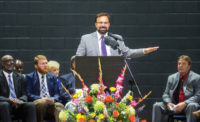Owner Oracle Corp.
Lead Design Firm, Structural Engineer and Landscape Architect DES Architects + Engineers
General Contractor XL Construction
Civil Engineer BKF
MEP Designer Integral Group
Sited in Redwood City, Calif., adjacent to both San Francisco Bay and Oracle Corp.’s corporate campus, the 64,000-sq-ft aluminum, glass and wood-paneled Design Tech High School project benefited from the input of a trio of primary decision-makers: Oracle, the Oracle Foundation and the charter school itself. However, another set of key influencers also contributed to the school’s unusual delivery: the students themselves.
From the day that DES Architects + Engineers made their project pitch, it was clear that the students of “d.tech” would have a strong voice in their school’s design, says Tom Gilman, president with the architectural firm.
Describing the design effort as a “full-on collaborative approach,” Gilman says instructors and parents also weighed in on classroom layout and other items. “It was something that really made this project much more fulfilling and really unique.”
Tasked early on with scaling back the design in order to reduce the project’s budget by about 20%, the team focused on delivering maximum flexibility “so that the building could evolve as the education model evolved,” says Dawn Jedkins, associate principal with DES.
The evolution of d.tech’s education model started with the charter school’s founding in 2014, and the fine-tuning of its educational approach is still ongoing. Until the $33.5-million project’s completion in November 2017, the high school had been housed across various temporary spaces.
The focus on flexibility forced the team to look at space utilization, with the result being a “much more efficient” building, says Jedkins. Classrooms were designed to be subject-agnostic, with operable walls enabling staff and students to customize the space. Oracle also provided the school with shared access to its conference center adjacent to the high school.
Along 1,200 ft of the project, crews restored land along the shoreline by revegetating the slopes with native plants. Contractors also upgraded the bayside levee to meet 100-year storm requirements at anticipated 2070 sea levels.







